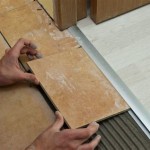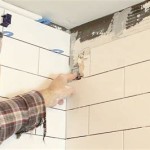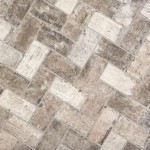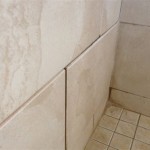How to Remove Asbestos Floor Tile Adhesive From Inside a House
Asbestos was a common material used in building construction for much of the 20th century due to its heat resistance and durability. This included use in floor tiles and the adhesive used to secure them. If a property built before the 1980s is undergoing renovations or demolition, removing old floor tiles may expose asbestos-containing adhesive. Understanding the risks involved and implementing proper safety measures is crucial when dealing with such material.
The term “asbestos” refers to a group of naturally occurring silicate minerals composed of thin, fibrous crystals. These fibers can be separated into durable threads and used in various applications. Asbestos materials were widely used in construction, including cement, roofing, flooring, and insulation. While durable and fire-resistant, asbestos poses significant health risks when its fibers become airborne and are inhaled. These microscopic asbestos fibers can lodge in the lungs and, over time, cause serious illnesses, including asbestosis (scarring of the lungs), lung cancer, and mesothelioma (a cancer of the lining of the lungs, abdomen, or heart). The latency period between exposure and the development of these diseases can be decades, making it critical to minimize or eliminate exposure.
Identifying asbestos-containing materials (ACM) requires professional testing. Because asbestos fibers are microscopic, visual inspection alone is not reliable. A qualified asbestos inspector can take samples of the suspected adhesive, which are then sent to an accredited laboratory for analysis. This analysis will determine whether asbestos is present and, if so, the type and concentration. Before undertaking any removal work, it is imperative to have suspect adhesive tested. This ensures the appropriate safety measures are taken, protecting those performing the work and anyone else who may be exposed.
The removal of asbestos floor tile adhesive is not a typical do-it-yourself project. Regulations vary by jurisdiction, but generally, it is recommended, and often legally required, to hire a licensed asbestos abatement contractor. These professionals have the training, equipment, and experience to safely remove asbestos and dispose of it according to environmental regulations. Attempting to remove asbestos without adequate knowledge and protective equipment can lead to significant health risks. Choosing a licensed contractor ensures the work is performed safely and legally, minimizing the potential for future liability.
Key Point 1: Understanding the Hazards and Regulations
The primary danger associated with asbestos is inhalation of airborne fibers. Disturbing asbestos-containing adhesive, such as by scraping, sanding, or breaking it, can release these fibers into the air. Once inhaled, these fibers can become permanently lodged in the lungs, leading to long-term health problems. The extent of the risk depends on several factors, including the concentration of asbestos in the material, the duration and intensity of exposure, and individual susceptibility.
Federal, state, and local regulations govern the handling, removal, and disposal of asbestos-containing materials. These regulations are designed to protect public health and the environment. The Environmental Protection Agency (EPA) and the Occupational Safety and Health Administration (OSHA) are the primary federal agencies involved in asbestos regulation. OSHA sets worker safety standards, while the EPA regulates asbestos in the environment. Many states also have their own asbestos regulations, which may be stricter than federal regulations. Before beginning any removal work, it is crucial to understand the specific regulations in the area.
These regulations often dictate the need for permits, worker training, specific removal procedures, and proper disposal methods. Failure to comply with these regulations can result in significant fines and legal penalties. Consulting with a qualified asbestos consultant or abatement contractor can help ensure compliance and minimize the risk of liability.
Key Point 2: Safe Removal Procedures
If professional asbestos abatement is deemed unnecessary or, in limited circumstances, if DIY removal is permitted by local regulations and the homeowner chooses to proceed, strict safety precautions are paramount. The goal is to minimize the release of asbestos fibers into the air. This involves carefully controlling the work area and using appropriate personal protective equipment (PPE).
Preparing the work area involves several steps. First, the area should be isolated from the rest of the house. This can be achieved by sealing off doorways and vents with plastic sheeting and duct tape. All furniture and belongings should be removed from the room. The floor should be thoroughly wetted down with water containing a surfactant, such as dish soap. This helps to bind the asbestos fibers and prevent them from becoming airborne. The goal is to create a negative pressure environment, meaning air is drawn into the work area rather than escaping, preventing fibers from spreading to other areas of the house. This is ideally achieved using a HEPA-filtered air scrubber.
Appropriate PPE is essential for anyone involved in the removal process. This includes a properly fitted respirator with HEPA filters, disposable coveralls, gloves, and shoe covers. The respirator should be NIOSH-approved and fit-tested to ensure a proper seal. The coveralls should be made of a non-porous material and should be taped at the wrists and ankles to prevent asbestos fibers from entering. Gloves should be disposable and made of a material resistant to the cleaning solutions used. Shoe covers prevent tracking asbestos fibers outside the work area.
The adhesive itself should be removed using methods that minimize dust creation. Scraping with a dull scraper or using a chemical adhesive remover specifically designed for asbestos-containing materials are preferred methods. Avoid sanding, grinding, or using power tools, as these will generate significant amounts of airborne asbestos fibers. As the adhesive is removed, it should be immediately placed into sealed plastic bags labeled as containing asbestos waste. The bags should be double-bagged to prevent leaks.
After the removal is complete, the work area must be thoroughly cleaned. This involves wet-wiping all surfaces with a damp cloth or sponge. The cloths and sponges should be disposed of as asbestos waste. A HEPA-filtered vacuum can be used to clean the floor and other surfaces, but a standard vacuum cleaner should never be used, as it will spread asbestos fibers into the air. The plastic sheeting used to seal off the work area should be carefully removed and disposed of as asbestos waste.
Key Point 3: Disposal and Post-Removal Testing
Proper disposal of asbestos-containing waste is critical to prevent further exposure. Asbestos waste must be disposed of in accordance with federal, state, and local regulations. This typically involves transporting the waste to a designated landfill that accepts asbestos. The waste must be properly packaged and labeled to prevent accidental exposure during transportation and disposal.
The sealed bags containing the asbestos waste should be labeled with the appropriate warning labels, indicating the presence of asbestos. The labels should include the name and address of the asbestos abatement contractor (if applicable) and the date of removal. The waste must be transported in a sealed container or vehicle to prevent the release of asbestos fibers into the environment. Contacting the local waste management authority is critical to determine the specific disposal requirements in the area.
Following the removal and cleaning, it is recommended to have the area tested to ensure that asbestos fibers have been adequately removed. This testing is typically performed by an independent asbestos consultant who can collect air samples and analyze them to determine the concentration of airborne asbestos fibers. If the air samples meet the required clearance levels, the area can be considered safe for occupancy. If the air samples exceed the clearance levels, additional cleaning and testing may be necessary.
Maintaining detailed records of all asbestos-related activities is essential. This includes the initial inspection report, laboratory analysis results, removal procedures, disposal records, and post-removal testing results. These records provide documentation of the work performed and can be valuable in the event of future questions or concerns. Keeping these records indefinitely is highly recommended.
Dealing with asbestos floor tile adhesive requires caution, knowledge, and adherence to safety protocols. Prioritizing safety throughout the process can minimize the health risks associated with asbestos exposure. Consulting with qualified asbestos professionals is always advisable to ensure the work is performed safely and in compliance with all applicable regulations.

How Much Does Asbestos Bitumen Glue Adhesive Removal Cost

How To Remove Asbestos Floor Tiles Safely

Asbestos Bitumen Glue Adhesive Removal Cost Guide For 2025

Asbestos Floor Tile Removal Cost Guide For 2025

Asbestos Floor Tile Removal Vinyl Thermoplastic And Bitumin

What To Do With Wet Asbestos Floor Tile And Black Adhesive

Asbestos Tile Floor Revamp Concrete Overlay Transformation

How To Remove Black Mastic Or Carpet Glue From A Concrete Floor Www Sealgreen Com 800 997 3873

Asbestos Tile Removal Abatement Pro

Asbestos Floor Tile Is It Safe To Remove By Yourself Virgin Carpets Inc
Related Posts








